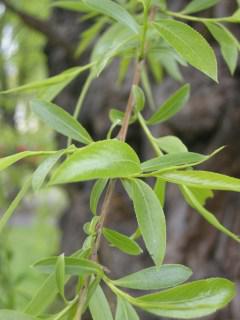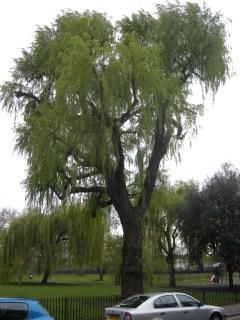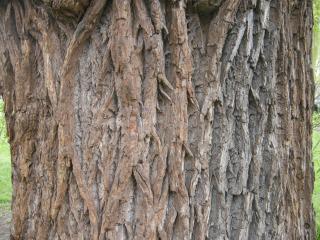
Salix alba Leaf (07/04/2012, London)
Position: Full sun to partial shade
Flowering period: Spring
Soil: Moist, well drained
Eventual Height: 25m
Eventual Spread: 15m
Hardiness: 4a – 9b
Family: Salicaceae
Salix alba is a fast growing medium/ large deciduous tree. Its leaves are alternate, lanceolate, serrulate, are covered in very fine silky white hairs (in particular on the underside) and are up to 8cm long and 1.5cm broad. Its branches are slender in character and droop at their tips. Its bark is gray brown and deeply fissured in older trees and its trunk may achieve a diameter of 1m. The flowers are dioecious, producing male and female catkins on seperate trees. The male catkins are up to 5cm long, the female 4 cm long at pollination. The female catkins lengthen as the fruit matures. Its fruit is a minute seed which have a tuft of silky hairs attached to it at one end. The roots of this tree are shallow and wide spreading.

Salix alba (07/04/2012, London)
Salix alba, commonly known as White Willow, is native to Europe (including the UK), western and central Asia. Traditionally, the wood of this trees has been used in the manufacture of cricket bats and the twigs used in basket weaving.
The etymological root of the binomial name Salix is derived from the old Latin name for the willow tree and is possibly derived from the old Celtic ‘sal’ meaning near and ‘lis’ meaning water. Alba is from the latin meaning ‘white’, referring to the underside of the leaves.
The landscape architect may find Salix alba useful, where space permits, as a large specimen tree particularly in wet locations. This tree may be pollarded or stooled. It can also be used as an effective wind break. Care should be taken when locating this trees as its roots may disturb foundations and drainage runs. It will tolerate maritime conditions.
Ecologically, S. alba attracts insects, including bees, who pollinate this tree.
The Royal Horticultural Society has given S. alba var. sericea and S. alba var. vitellina their prestigious Award of Garden Merit in 1993.

Salix alba Bark (07/04/2012, London)
S. alba prefers moist, fertile, deep, well-drained soils. It tolerates most pH of soil. It will tolerate periods of severe flooding and dislikes periods of extended drought.
S. alba requires little maintenance. The pollarding or stooling of this tree should be carried out in early spring, before leaf burst.

